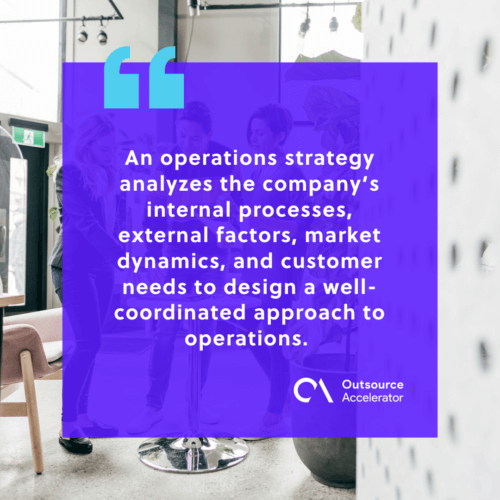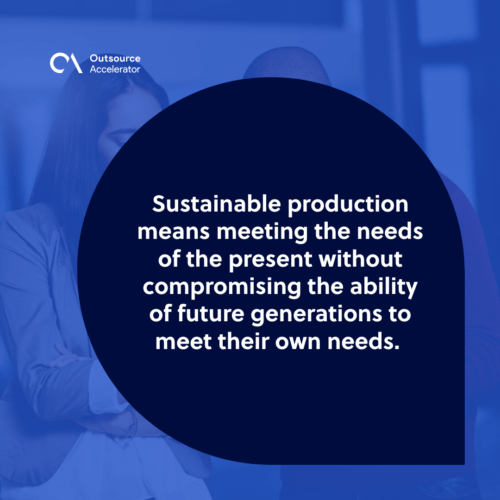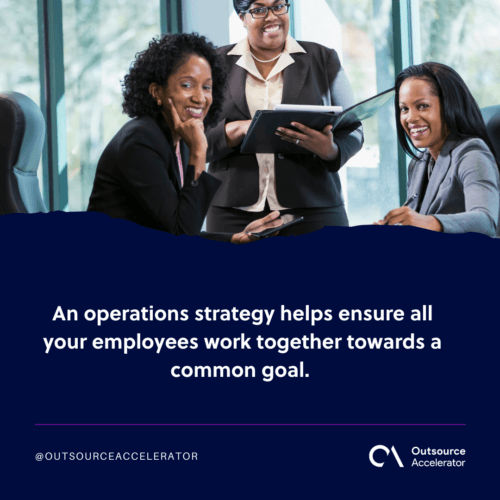Major components of an operations strategy

Whether you’re running a small business or a large corporation, having a solid operations strategy is crucial to your success. An effective strategy helps you streamline your business operations, reduce costs, increase efficiency, and boost your bottom line.
But what exactly is an operations strategy, and what do you need to create one that works for your business?
What is an operations strategy?
An operations strategy is a high-level plan that outlines how a company intends to use its resources to achieve its business objectives. It involves making strategic decisions and aligning operational activities with the overall business strategy.
An operations strategy analyzes the company’s internal processes, external factors, market dynamics, and customer needs to design a well-coordinated approach to operations.

Elements of an operations strategy
The elements of an operations strategy encompass various components. These parts collectively form a cohesive plan to optimize an organization’s operations and achieve its business objectives.
These elements include:
Mission and objectives
An organization’s mission statement defines its purpose and identifies the end goals it seeks to achieve. A well-crafted mission statement should be clear, concise, and understandable.
Ask yourself questions like:
- What’s the purpose of your organization?
- What do you want to accomplish?
- What are your long-term goals?
Resource allocation
Resource allocation deploys resources to your company’s most effective and profitable use. It helps businesses cost-effectively meet their goals.
Resources can be allocated to departments or projects based on a variety of factors, including:
- Personnel skills and abilities
- Project complexity
- Project risk level
- Project importance to company objectives
Capacity planning
Capacity planning predicts and manages demand, supply, and inventory levels to ensure sufficient capacity to meet customer needs.
It can be divided into two categories:
- Forecasting capacity requirements – This forecasts the capacity required in future periods.
- Planning capacity resources – This decides what resources are required to meet the forecasted capacity need.
This element of an operations strategy ensures that future requirements are met without resorting to emergency measures.
Process design and improvement
Process design refers to how you structure tasks within your business. It makes existing processes more efficient and creates new ones based on customer needs.
Processes should be designed to be repeatable, scalable, flexible, and transparent.
At the heart of an operations strategy, a good process design ensures you deliver quality products and services at the right cost while meeting your customer’s expectations.
Quality management
A good operations strategy begins with quality management. Quality management identifies, analyzes, and solves quality problems to achieve customer satisfaction.
The ISO 9000 standard defines a set of international standards for quality management and quality assurance.
This includes:
- Quality systems
- Quality metrics
- Quality audits
Supply chain management
In the context of an operations strategy, supply chain management refers to a set of activities that help an organization manage its supply chain. A supply chain is a network of groups that provide goods or services to one another.
Supply chain management deals with all aspects of supply chain activities to meet customer needs at a competitive price while maximizing profitability for suppliers and retailers.
Technology and innovation
Technology and innovation allow businesses to automate processes, improve quality control, streamline communications, and use resources more efficiently.
Technology and innovation are key drivers of growth in the business world. How a company integrates technology can directly impact its operations strategy and how it provides service.
Performance measurement and KPIs
An effective operations strategy requires a process for measuring performance against predetermined goals and objectives.
Performance management evaluates the effectiveness of your operations strategy and determines how well it aligns with your goals. In the same way, key performance indicators (KPIs) measure if the objectives set are being met or not.
Risk management
Risk management helps you deal with risks to improve your business performance. The process typically involves three steps:
- Identify all possible risks
- Assess risks based on probability and impact
- Plan how to reduce and eliminate risks
Sustainability and environmental impact
Sustainable production means meeting the needs of the present without compromising the ability of future generations to meet their own needs.
Therefore, an operations strategy must consider how it will affect the environment in which it is conducted. Companies must also consider how their operations affect human health.

Types of operations strategies
Various operations strategies can be employed based on the organization’s objectives and industry.
Here are some common types:
Core competency strategy
This operations strategy focuses on what the company does best. It is a differentiation plan where you try to be different from your competitors in order to gain a competitive advantage.
This type is usually adopted by established companies with a good reputation in their industry.
Corporate strategy
A corporate strategy is a broad-based plan to guide an organization’s growth and long-term direction. The term can be described as a corporation’s activities’ focus, direction, and scope.
This also includes deciding whether to enter new markets and product lines or withdraw from existing ones.
Competitive strategy
This is a company’s reaction to the competitive environment. This operations strategy aims to gain and maintain a competitive advantage by offering superior products, distribution channels, and promotion efforts.
Customer-driven strategy
This focuses on customers and their needs. It emphasizes the importance of meeting customer demands and providing value in terms of price, quality, and service.
A customer-driven approach uses data from past experiences to make informed decisions about how it should operate in the future.
Product/service strategy
This operations strategy drives an organization’s product line or service offering. It includes the company’s product mix, channel mix, pricing strategy, and target market.
This strategy should change as the industry evolves and competitors enter and leave the market.
Why should a business have an operations strategy?
Here are the key reasons a business should have an operations strategy:
Alignment with business goals
An operations strategy helps ensure all your employees work together towards a common goal.
It provides a structure for how things should be done and creates consistency across departments, ultimately leading to better efficiency.

Efficiency and productivity
Operational efficiency increases profitability. A business’s operations strategy can help its employees coordinate efforts so that they work effectively to produce what the customer wants when they want it.
Adaptability to market changes
A good operations strategy helps you adapt to a constantly changing business environment. It lets you respond quickly to new opportunities or market threats by leveraging your strengths and assets.
Resource utilization
With an operations strategy, you can ensure that resources are utilized optimally. This balanced resource allocation helps the business maintain a stable operational environment.
Long-term sustainability
Without an operations strategy, a company will fail to sustain itself over time. They won’t be able to compete, adapt quickly enough, keep up with new technologies, or stay current on industry trends.
This all leads to stagnation and a decline in profits. Help ensure your business is sustainable by implementing an operations strategy.







 Independent
Independent




